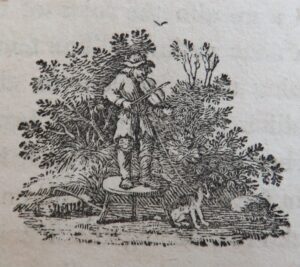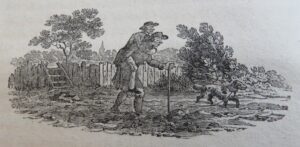Stephen Martin
Thailand
The artist and naturalist Thomas Bewick (1753–1828) was one of the Enlightenment’s leading polymaths. He wrote groundbreaking books on birds1 and mammals,2 as well as an autobiography, which is absorbing and charming. This Memoir of Thomas Bewick3 is a delightfully detailed window on the eighteenth century and Regency periods, focusing on his ordinary background in North East England. Bewick was also a moral philosopher and sharp observer of rights and wrongs in the society of his time. Besides carving bird and mammal woodcuts, he illustrated his own and other writers’ works with vignettes—woodcut engravings of genre scenes used as sectional tailpieces. Many make moral points and have nothing at all to do with the preceding text or animal print.
John James Audubon met Bewick twice in Newcastle upon Tyne in 1827 while canvassing for subscribers for The Birds of America. He named Bewick’s long-tailed wren after him. Bewick’s swan was also dubbed in his honor in 1830. Audubon referred to the old man as “a person too well known for his admirable talents as an engraver on wood, and for his beautiful work on the Birds of Great Britain, to need any eulogy of mine.” On Thomas Bewick’s woodcuts for Poems by Goldsmith and Parnell, the editor William Bulmer wrote in his foreword: “They have been executed with great care, and I may venture to say, without being supposed to be influenced by ancient friendship, that they form the most extraordinary effort of the art of engraving upon wood, that ever was produced in any age, or any country. Indeed it seems almost impossible that such delicate effects could be obtained from blocks of wood.”
Monsters in the dark

A traveler with a pack over his shoulder (Fig 1) sees two bizarre, horned, devilish monsters looming out of the hedge.4 Two branches stretch towards him, seen as menacing arms of the right-hand beast. He is not using his stick to walk, but is lifting it in defense. It is dark, the moon is up, fatigue is likely, and he might have had a few ales, hence foolishly going home too late. There also appears to be the gallows in the left middle ground. Those factors could all contribute to fear on top of image distortion in a vicious circle.
Here, Bewick engraved an illusion. Illusions are sensory distortions where there is a stimulus—the hedge, in this case, perceived as monsters. Hallucinations, on the other hand, are perceptions without a stimulus. That would be seeing monsters with nothing in the field of vision to trigger it. Another Bewick vignette shows a dog, alone, barking at a demon in a hedge. We cannot say if Bewick meant that image to be supernatural or if he had seen old dogs hallucinate, barking at nothing. If so, he attributed the same kind of perceptual abnormalities in humans to dogs as well. Interestingly, when Mary Shelley published Frankenstein twenty-one years after Bewick’s Monsters, Victor Frankenstein used the related words demon, devil, fiend, and spectre, conjuring up similar images to describe his creation.5

The blind fiddler
He is standing on a large tripod platform, playing, with his collie mongrel guide dog still tied to his belt.6 (Fig 2) Presumably the platform lets him project his performance further and keeps him out of reach of passing boots. His stick is leaning on an eroded stone that appears to have the remains of a Gothic script, the kind of fragmented inscription that you might see on the ground at some of North East England’s ruined abbeys. In this woodcut, Bewick seems to be saying one forges on despite adversity and things falling to unrecognizable pieces. Bewick noted as an old man that he had to rest because of fatigue “of the optic nerve” and delegate to his apprentices. Given that this carving is only 37 x 29 mm, you can see his concern. Losing sight was significant for him, both as a threat to his professional activity and creativity and as a symbol of aging. His use of the anatomical term is striking. His workshop was 200 meters away from the Newcastle Barber Surgeons’ dissecting rooms—one suspects he had a few lessons.
The lame and the blind

The lame man’s white shoulder crutch lies at an angle in front of the style, which he has directed the blind man to carry him over.7 (Fig 3) The engraving of the crutch is so subtle it is hard to spot and conceals the extra adversity of crossing the style. The spaniel mongrel guide dog is trailing his lead in the dirt, and the blind man leans heavily on his stick. In both blindness vignettes, use of the dog and the stick in the Regency period is revealing, though there are similar Roman and medieval images. The parable of the lame and the blind appears to have ancient Greek origins, but was not written by Aesop, nor is it biblical. It was illustrated in the Renaissance. Bewick later did the engravings for Aesop’s Fables, a subject close to his heart, which he also edited in 1818.8 He revealed some of his thinking in the preface: “The philanthropist views with feelings of benevolence the wavering balance, and adds those he finds on the confines, to the number of the virtuous; while the misanthrope, with gloomy malignity, endeavours to include within the circle of vice, those who are standing upon the ill-defined line of division, and thus swells the number of the bad.” The blind and the lame is another parable of forging on in adversity with mutual assistance, as well as an insight into eighteenth-century blindness.
Notes
- Bewick T. History of British Birds. Vol I, Beilby and Bewick, Newcastle upon Tyne, 1797. Vol II, Bewick, Newcastle and Longman and Co London, 1816.
- Bewick T. A General History of Quadrupeds. Bewick and Son Newcastle, Longman and Co, London, Wilson and Sons, York. 1824.
- Bewick T. A Memoir of Thomas Bewick. Jane Bewick, Gateshead, 1862. His daughter Jane edited his notes and published posthumously.
- Bewick T. History of British Birds. Vol I. Tailpiece to Of the Shrike, p 57, 1797.
- Baldick, C. In Frankenstein’s shadow: myth, monstrosity, and nineteenth-century writing. Oxford: Clarendon Press, 1987.
- Bewick T. History of British Birds. Vol I. Tail piece to The Ring Ouzel, p 93, 1797.
- Bewick T. History of British Birds. Vol II, 1816, p. vi. Drawn by R Johnson and engraved by Luke Clennell, in Bewick’s workshop under his direction.
- Bewick T. The Fables of Aesop and Others. Bewick and Son, Newcastle, Longman and Co, London, 1818. A different Lame and the Blind is engraved, P 365, with an explanation. The artist is Bewick, assisted by apprentices William Harvey, William Temple, and his son Robert Bewick. They depicted the dog tied to the walking stick and the crutch against a hedge. The tailpiece is a man walking against the wind holding his hat. Apprentice contributions were reviewed in: Bewick T. My Life. Ed Iain Bain. The Folio Society, London, 1981.
STEPHEN MARTIN is a retired British psychiatrist who now runs a museum and education project in Thailand.

Leave a Reply